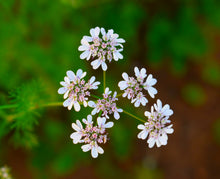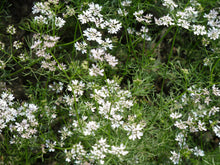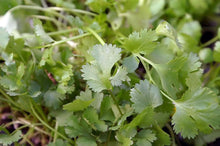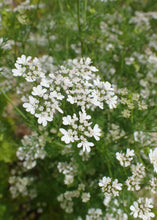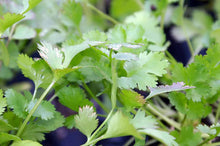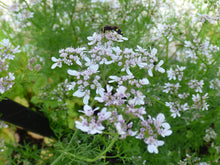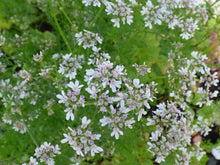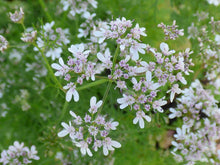
Common Name: cilantro
Type: Annual
Family: Apiaceae
Native Range: Western Asia
Zone: 2 to 11
Height: 1.50 to 2.00 feet
Spread: 1.00 to 1.50 feet
Bloom Time: Seasonal bloomer
Bloom Description: White to pink to pale lavender
Sun: Full sun to part shade
Water: Medium
Maintenance: Low
Suggested Use: Annual, Herb
Flower: Showy
Leaf: Fragrant
Fruit: Showy, Edible
Easily grown in average, medium moisture, well-drained soils in full sun to light shade. Light afternoon shade helps avoid possible sun scald in hot summer climates. Best growth occurs in cool and dry summer climates. Plants dislike areas with high humidity and frequent rain. Seeds may be planted directly in garden soil after the last spring frost date. They may also be planted in pots. Plants grow rapidly (pinching off young leaves can begin in 30 days). Snip off flower stems before flowering to prolong harvest of leaves. Plant new seed every 2 weeks to insure a continuous crop of leaves. Allow some plants to flower and seed if harvest of coriander seed is desired. Seeds are ready for harvest in 90 days. Plants tend to bolt easily (abandon leaf growth, flower, seed and die) in hot summer climates. A late summer planting of seed can be done for fall harvest of leaves but seed will not mature before frost. Plants are annuals but have naturalized in some parts of North America.
Coriandrum sativum is a warm weather annual that is commonly grown in herb gardens for its lacy, strong-scented foliage (cilantro) and its aromatic seeds (coriander). It is native to southern Europe and the western Mediterranean. It typically grows in a basal clump to 24" tall and to 18" wide. Plants may sprawl in the garden. Finely-divided upper leaves are fern-like. Broad-lobed lower leaves resemble those of Italian parsley. Cilantro leaves are used for flavoring a number of food dishes including salads, salsas, meats, sauces and soups. Leaves are best used fresh, but may be frozen in ice cube trays for later use. Stems are also edible when young. Coriander seeds ripen in round, yellow-brown pods. Seeds are typically ready for harvest about 90 days after seed is planted (late summer to early autumn in St. Louis). Mature seeds have a pleasantly sweet-spicy fragrance and are used for flavoring sauces, meats, sausages, stews, chutneys, pies and cakes. Seeds are an ingredient found in curry powder. By contrast, young seeds are never used for culinary purposes because they have an unpleasant fragrance and bitter taste. White to pink to pale lavender flowers bloom above the foliage clump in loose compound umbels (to 2" across). Swallowtail butterflies feed on plant leaves.
Type: Annual
Family: Apiaceae
Native Range: Western Asia
Zone: 2 to 11
Height: 1.50 to 2.00 feet
Spread: 1.00 to 1.50 feet
Bloom Time: Seasonal bloomer
Bloom Description: White to pink to pale lavender
Sun: Full sun to part shade
Water: Medium
Maintenance: Low
Suggested Use: Annual, Herb
Flower: Showy
Leaf: Fragrant
Fruit: Showy, Edible
Easily grown in average, medium moisture, well-drained soils in full sun to light shade. Light afternoon shade helps avoid possible sun scald in hot summer climates. Best growth occurs in cool and dry summer climates. Plants dislike areas with high humidity and frequent rain. Seeds may be planted directly in garden soil after the last spring frost date. They may also be planted in pots. Plants grow rapidly (pinching off young leaves can begin in 30 days). Snip off flower stems before flowering to prolong harvest of leaves. Plant new seed every 2 weeks to insure a continuous crop of leaves. Allow some plants to flower and seed if harvest of coriander seed is desired. Seeds are ready for harvest in 90 days. Plants tend to bolt easily (abandon leaf growth, flower, seed and die) in hot summer climates. A late summer planting of seed can be done for fall harvest of leaves but seed will not mature before frost. Plants are annuals but have naturalized in some parts of North America.
Coriandrum sativum is a warm weather annual that is commonly grown in herb gardens for its lacy, strong-scented foliage (cilantro) and its aromatic seeds (coriander). It is native to southern Europe and the western Mediterranean. It typically grows in a basal clump to 24" tall and to 18" wide. Plants may sprawl in the garden. Finely-divided upper leaves are fern-like. Broad-lobed lower leaves resemble those of Italian parsley. Cilantro leaves are used for flavoring a number of food dishes including salads, salsas, meats, sauces and soups. Leaves are best used fresh, but may be frozen in ice cube trays for later use. Stems are also edible when young. Coriander seeds ripen in round, yellow-brown pods. Seeds are typically ready for harvest about 90 days after seed is planted (late summer to early autumn in St. Louis). Mature seeds have a pleasantly sweet-spicy fragrance and are used for flavoring sauces, meats, sausages, stews, chutneys, pies and cakes. Seeds are an ingredient found in curry powder. By contrast, young seeds are never used for culinary purposes because they have an unpleasant fragrance and bitter taste. White to pink to pale lavender flowers bloom above the foliage clump in loose compound umbels (to 2" across). Swallowtail butterflies feed on plant leaves.







